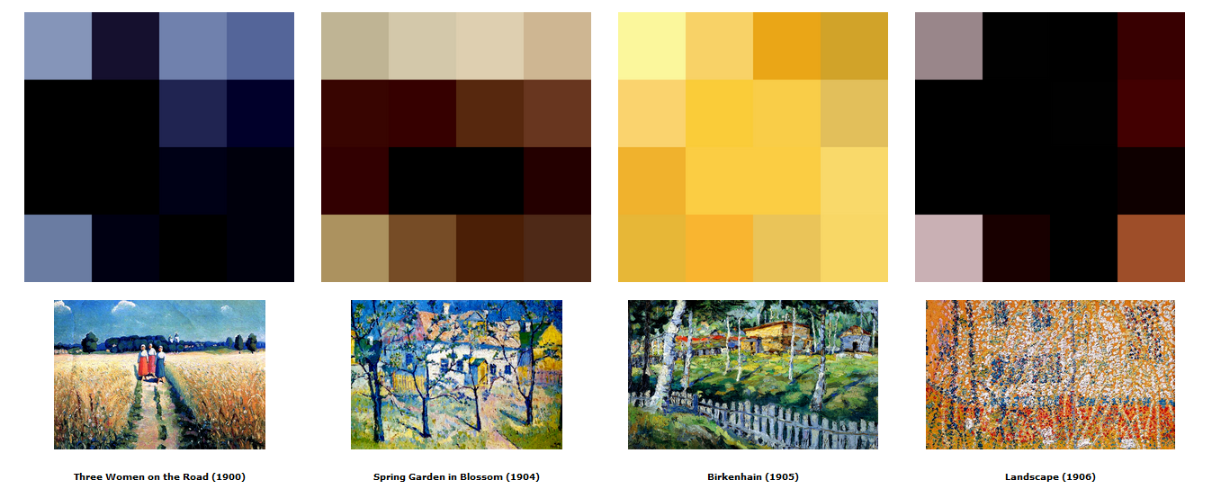Black square: Unmasked -Nature, Tom Chambers
Unmasked

The premise for the project – according to Kazimir Malevich, the originator of Suprematism and creator of “Black Square”: “To the Suprematist, the visual phenomena of the objective world are, in themselves, meaningless; the significant thing is feeling, as such, quite apart from the environment in which it is called forth.” Suprematism represents an anti-materialist, anti-utilitarian philosophy.
Malevich continues to state, “Art no longer cares to serve the state and religion, it no longer wishes to illustrate the history of manners, it wants to have nothing further to do with the object, as such, and believes that it can exist, in and for itself, without ‘things’ (that is, the “time-tested well-spring of life”).” (Part II of The Non-Objective World, 1927)
To unmask “Black Square” is to remove this equalizer of all art movements, to reveal such (art movements) as insignificant in the mind of Malevich on behalf of Suprematism. The only true reality for Malevich – absolute non-objectivity. He states, “A blissful sense of liberating non-objectivity drew me forth into a ‘desert’, where nothing is real except feeling.” (Part II of The Non-Objective World, 1927)
Exhibition:
“Black Square Unmasked”, “Black Square Interpretations and Other Suprematist Explorations” (two-person show with Max Semakov), CaviArt Gallery, Russian Cultural Center, Houston, Texas, March 6 – April 7, 2015.
Suprematist Representations of Kazimir Malevich’s Work PRIOR TO “BLACK SQUARE”

Digital reproductions of Kazimir Malevich’s work are magnified to reveal pixel configurations that rival works in Suprematism, Abstraction, Minimalism, Geometric, and Color Field art movements. They are brought to the forefront via these early works to celebrate Malevich’s latent and ultimate creativity which gave way to Suprematism with the display of “Black Square” and other works in 1915 as part of the Last Futurist Exhibition of Paintings 0,10. The perusal of these “pixelscapes” shows an occasional “Black Square”, “Red Square”, “White Square”, and “Black Cross” that Malevich created as iconic representations of his art movement. The overall geometry and color fields are in keeping with Suprematism.
According to kazimir-malevich.org:
Peasant art surrounded him in childhood. He delighted in peasant embroidery, and in decorated walls and stoves. He himself was able to paint in the peasant style. He studied drawing in Kiev from 1895 to 1896. In 1904. After the death of his father, he moved to Moscow. He studied at the Moscow School of Painting, Sculpture and Architecture from 1904 to 1910 and in the studio of Fedor Rerberg in Moscow (1904-1910). In 1911 he participated in the second exhibition of the grop Soyuz Molodyozhi (Union of Youth) in St. Petersburg, together with Vladimir Tatlin and, in 1912, the group held its third exhibition, which included works by Aleksandra Ekster, Tatlin and others. In the same year he participated in an exhibition by the collective Donkey’s Tail in Moscow.
In March 1913, a major exhibition of Aristarkh Lentulov’s paintings opened in Moscow. The effect of this exhibition was comparable with that of Paul Cezanne in Paris in 1907, as all the main Russian avant-garde artists of the time (including Malevich) immediately absorbed the cubist principles and began using them in their works. Already in the same year the Cubo-Futurist opera “Victory Over the Sun” with Malevich’s stage-set became a great success. In 1914, Malevich exhibited his works in the Salon des Independants in Paris together with Alexander Archipenko, Sonia Delaunay, Aleksandra Ekster and Vadim Meller, among others.
Black square merge: Nature

This project is a continuation of Chambers’ experimentation with Kazimir Malevich’s “Black Square” and Suprematism. He merges photographs of nature with “Black Square” to create a zone of Suprematism via the pixel(s). The merge results in a loss of color (variations of gray including achromatic grayscale shades, which lie between white and black colors). The project is in keeping with Malevich’s Suprematism – the feeling of non-objectivity – the creation of a sense of bliss and wonder via abstraction.
Malevich founded the art movement, Suprematism in Moscow, 1913 as a parallel to Constructivism. Suprematism (“supremacy of forms”) is a study in abstraction conceived in itself – non-objective and not related to anything except geometric shapes and colors – and a precursor to Minimalism.
Under Suprematism I understand the supremacy of pure feeling in creative art. To the Suprematist the visual phenomena of the objective world are, in themselves, meaningless; the significant thing is feeling, as such, quite apart from the environment in which it is called forth. I took refuge in the square form and exhibited a picture which consisted of nothing more than a black square on a white field. It is filled with the spirit of nonobjective sensation which pervades everything. This is no empty square, but rather the feeling of non-objectivity.
The premise behind “Black Square Merge: Nature” becomes one of homage a second time – first, “My Dear Malevich” – by utilizing photographs of nature to explore at the pixel level – transformation into aesthetic fields of “Pixelscapes” via the merge of Malevich’s “Black Square” – to rekindle his thoughts about creation. He states, “No phenomenon is mortal, and this means not only the body but the idea as well, a symbol that one is eternally reincarnated in another form which actually exists in the conscious and unconscious person.” In his book, The Non-Objective World, Malevich describes the inspiration for his “Black Square”. He states, “I felt only night within me, and it was then that I conceived the new art, which I called Suprematism.” “Black Square Merge: Nature” represents this reincarnation that he talks about; and the loss of color of the pixels due to the merge of the color photograph with his “Black Square” conjures up his feelings of “night within me” and their consequent creation of the new art, Suprematism.
Review by JD Jarvis, Art Critic/Artist and coauthor of Going Digital: The Practice and Vision of Digital Artists (ISBN 1-59200-918-2) [USA]:
“Well over a decade ago, Tom R. Chambers began to look at the pixel within the context of Abstraction and Minimalism:
His work in this vein draws our attention to the visual singularity that makes up everything we see in the digital universe. Since the pixel equates to what we call a ‘subatomic particle’ within our physical universe, Chambers’ work engages us directly with the feeling that the Russian Suprematist described as the non-objective spirit that pervades everything and pays due homage their belief in the ability of Abstraction to convey ‘the supremacy of pure feeling in creative art’. Indeed, an earlier edition within this long series of work explored the visual meaning behind the works and words of Suprematist painter and theorist Kazimir Malevich.
In this latest edition of images and prints Chambers seeks to metaphorically merge inner and outer worlds by presenting photorealistic nature as it transitions into digital abstraction at the pixel level. ‘Black Square Merge: Nature’ is precisely what it says it is. We see, almost in cinematic form the movement from a picture of reality to a picture of pure abstraction. What this viewer finds most interesting is that area of transition between these absolutes. It satisfies me that in this grey area where nature begins to break down and abstraction appears to be taking hold that we find the greatest latitude and possibility for creative energy.
I was overcome, at first, by the sheer number of images in this edition, but when I saw on my computer screen a thumbnail of a large number of these works gathered on a single page I realized that each image is like a jewel and that the effect will be quite wonderful when the physical prints of these images are finally displayed back in the realm of physical reality. In such a display we will find ourselves inside that journey that Malevich described and which Tom R. Chambers so elegantly materializes.”
Exhibition:
“Black Square Merge: Nature”, “Black Square Interpretations and Other Suprematist Explorations” (two-person show with Max Semakov), CaviArt Gallery, Russian Cultural Center, Houston, Texas, March 6 – April 7, 2015.
You Might Also Like:
Van Luong (1)
 Kjell Zillen (4)
Kjell Zillen (4) Mels Dees (9)
Mels Dees (9) Gao Yu (4)
Gao Yu (4)Katya Lebedev (1)
Juan Dies (1)
 Anastasia Prahova (2)
Anastasia Prahova (2)Nena Nastasiya (7)
Taarn Scott (6)
 Cynthia Fusillo (20)
Cynthia Fusillo (20)Roberta Orlando (8)
 Nanda Raemansky (25)
Nanda Raemansky (25) Eliane Velozo (22)
Eliane Velozo (22)Leyya Mona Tawil (1)
Julia Dubovyk (2)
Jianglong (2)
 Iara Abreu (23)
Iara Abreu (23) Agathe Simon (1)
Agathe Simon (1)Rosetta Allan (1)
Elizaveta Ostapenko (5)
 Valentin Boiangiu (2)
Valentin Boiangiu (2) Wesley John Fourie (9)
Wesley John Fourie (9) Renato Roque (3)
Renato Roque (3)Rosa Gauditano (5)
Neerajj Mittra (34)
Ciana Fitzgerald (5)
Boris Moz (3)
 Katerina Muravuova (5)
Katerina Muravuova (5)Kyla Bernberg (1)
 Muyuan He (1)
Muyuan He (1)Liza Odinokikh (2)
 Amalia Gil-Merino (2)
Amalia Gil-Merino (2)Paulo Carvalho Ferreira (6)
 Anastasiia Komissarova (2)
Anastasiia Komissarova (2) Yumiko Ono (1)
Yumiko Ono (1) Stefania Smolkina (1)
Stefania Smolkina (1)Lena Adasheva (1)
 Zahar Al-Dabbagh (1)
Zahar Al-Dabbagh (1) Emily Orzech (6)
Emily Orzech (6) Fernanda Olivares (5)
Fernanda Olivares (5) Noor van der Brugge (3)
Noor van der Brugge (3) Ira Papadopoulou (2)
Ira Papadopoulou (2) Tom Chambers (8)
Tom Chambers (8) Titi Gutierrez (3)
Titi Gutierrez (3) Franz Wanner (2)
Franz Wanner (2) Crystal Marshall (6)
Crystal Marshall (6) Transpositions III (36)
Transpositions III (36) Riddhi Patel (3)
Riddhi Patel (3) Michele Kishita (2)
Michele Kishita (2)Damian Carlton (4)
 Deanna Sirlin (1)
Deanna Sirlin (1) Laura Salerno (3)
Laura Salerno (3) Nina Annabelle Märkl (12)
Nina Annabelle Märkl (12) Elina Fattakhova (1)
Elina Fattakhova (1) Tasha Hurley (1)
Tasha Hurley (1) Ian Hartley (2)
Ian Hartley (2) Laurence de Valmy (2)
Laurence de Valmy (2) Ilia Bouslakov (5)
Ilia Bouslakov (5) Andrea Ahuactzin Pintos (4)
Andrea Ahuactzin Pintos (4) Sveta Nosova (3)
Sveta Nosova (3)Carlos Carvalho (1)
 Maria Timofeeva (1)
Maria Timofeeva (1) Jinn Bug (2)
Jinn Bug (2) Johannes Gerard (3)
Johannes Gerard (3)Irène Mélix (1)
 Aba Lluch Dalena (3)
Aba Lluch Dalena (3) Fabian Reimann (1)
Fabian Reimann (1)Natalia Gourova (1)
 Kate Finkelstein (4)
Kate Finkelstein (4)Raina Greifer (1)
James McCann (2)
Naza del Rosal Ortiz (1)
 Jay Critchley Jay Critchley (1)
Jay Critchley Jay Critchley (1) Vicky Clarke (4)
Vicky Clarke (4) Maria Silva (4)
Maria Silva (4) Shir Cohen (5)
Shir Cohen (5) Peter Shenai (4)
Peter Shenai (4) Bo Choy (4)
Bo Choy (4)Alina Orlov (2)
 Olga Popova (3)
Olga Popova (3) Coco Spencer (2)
Coco Spencer (2) Filippo Fabbri (2)
Filippo Fabbri (2)Daniele Leonardo (5)
 SISTERS HOPE (1)
SISTERS HOPE (1) Scenocosme : Gregory Lasserre & Anais met den Ancxt (4)
Scenocosme : Gregory Lasserre & Anais met den Ancxt (4) Anne Fehres & Luke Conroy (6)
Anne Fehres & Luke Conroy (6) Olesya Ilenok (2)
Olesya Ilenok (2) Marie-Eve Levasseur (4)
Marie-Eve Levasseur (4) Natalia Tikhonova (2)
Natalia Tikhonova (2)Ildar Iakubov (1)
 Evgeniy Lukuta (7)
Evgeniy Lukuta (7) Jarkko Räsänen (5)
Jarkko Räsänen (5)Maria Guta (6)
Egle Kulbokaite Dorota Gaweda (6)
Thomas Kotik (1)
 Andrea Stanislav (3)
Andrea Stanislav (3)Ludmila Belova (1)
Alena Levina (1)
 Ilia Symphocat (2)
Ilia Symphocat (2)Yevgeniy Fiks (1)
Star Smart(Formerly Trauth) (18)
Jyoti Arvey (1)
Les Joynes (2)
 Ekaterina Ivanova (1)
Ekaterina Ivanova (1) Lev Shusharichev (1)
Lev Shusharichev (1)Michael Stebackov (5)
Ryan Griffith (3)
Lidia Gordeenko (3)
 Masha Danilovskaya (7)
Masha Danilovskaya (7) Irina Korotkaya (2)
Irina Korotkaya (2) WagtailFilms Oksana Bronevitskaia&Dmitry Zhukov (5)
WagtailFilms Oksana Bronevitskaia&Dmitry Zhukov (5)Kostya Diachkov (1)
Elena Sokolova (3)
Alexander Nikolsky (2)

